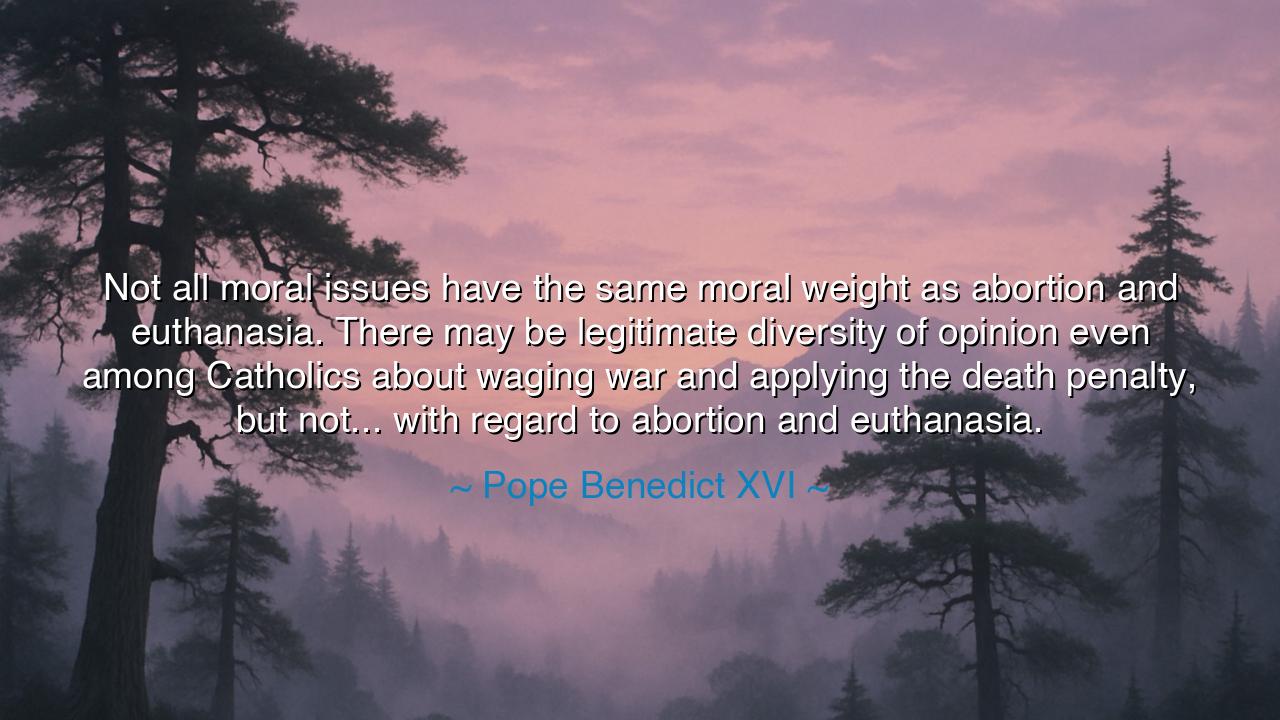
Not all moral issues have the same moral weight as abortion and
Not all moral issues have the same moral weight as abortion and euthanasia. There may be legitimate diversity of opinion even among Catholics about waging war and applying the death penalty, but not... with regard to abortion and euthanasia.






In the councils of moral reflection, hear Pope Benedict XVI (then Cardinal Joseph Ratzinger) speak with the clarity of a bell at dawn: “Not all moral issues have the same moral weight as abortion and euthanasia. There may be legitimate diversity of opinion even among Catholics about waging war and applying the death penalty, but not… with regard to abortion and euthanasia.” In a single breath he traces a hierarchy within the realm of conscience: some acts attack life at its root and admit no permission; other grave questions demand prudence, circumstance, and judgment. This is not a downgrading of the latter, but a warning about the former: certain wrongs are intrinsic, not dependent on calculus or context.
The meaning is double. First, he distinguishes between acts that are always and everywhere contrary to the good of the person—abortion and euthanasia—and matters that, though serious, can be evaluated under conditions and intention—war (e.g., criteria of a “just war”) and the death penalty (traditionally treated as permitted in narrow cases, though ever more restricted in modern teaching). Thus, conscience must weigh realities differently, not because compassion is selective, but because moral objects differ in kind. Second, he instructs the faithful that disagreement can exist about applications of prudential principles (strategy, policy, timing), while there can be no legitimate permission for the direct taking of innocent life.
As to the origin, these lines come from Ratzinger’s 2004 memorandum, “Worthiness to Receive Holy Communion: General Principles,” sent to U.S. bishops during public debate over politicians, policy, and the Eucharist. In that text he writes plainly: “There may be a legitimate diversity of opinion even among Catholics about waging war and applying the death penalty, but not however with regard to abortion and euthanasia.” The memo situates the principle within guidance on forming conscience and receiving Communion, not electioneering slogans.
To see the logic in motion, consider a parish discussion on public ethics. Neighbors disagree about a proposed military action and about sentencing policy; arguments weigh proportional risks, last resort, and protection of the innocent. The room is intense yet charitable, because prudential questions invite debate about means. Then the topic shifts to a bill enabling the direct ending of nascent or vulnerable life. Here the conversation changes key: the act itself—whatever the motive—targets the innocent. The parishioners realize why the Church speaks of moral weight differently: some choices are about how to pursue the good; others are about whether the person’s basic right to live will be honored at all. The hierarchy does not erase compassion for suffering; it sets a non-negotiable floor beneath it.
History offers a sterner example. Statesmen have long wrestled with war, sometimes finding that defense of the common good demanded force, sometimes repenting strategic folly. Likewise, many legal systems once held the death penalty permissible in rare cases to protect society, even as the Church increasingly urged mercy and alternatives. These judgments turn on facts and feasibility—on prudence. But wherever regimes normalized the direct destruction of innocent life—by policy, by medicine, by ideology—culture itself withered. Benedict’s distinction is therefore pastoral and protective: it shields the weakest while allowing reasoned debate where the object is not intrinsically evil.
Note, too, the tone: the statement is not a cudgel but a compass. It does not say war and capital punishment are light matters; it says that, as matters of application, they can admit varying conclusions among the well-formed, whereas abortion and euthanasia can never be chosen as means to a good end. Rightly heard, the principle fosters unity: it prevents us from flattening the moral landscape into a single, noisy plain, and it keeps us from treating every disagreement as a denial of first principles.
What, then, is the lesson? Form conscience with the hierarchy of truths in mind. Place the defense of innocent life at the center; then bring prudence, data, and dialogue to the hard questions of policy and force. Practice the ancient disciplines: seek the truth (study reliable sources and the Church’s social doctrine), judge with equity (distinguish intrinsic evils from prudential disputes), and act with charity (honor opponents where they pursue the good by different means). In public life and private counsel, keep speech precise: condemn what must never be done; reason together about what might be done and how.
Finally, some practical actions. 1) Read the 2004 General Principles paragraph in full and summarize it in your own words; let that become a touchstone in debates. 2) When faced with multiple grave issues, ask first: does this policy directly intend the death of the innocent? If yes, opposition is categorical; if no, move to prudential criteria. 3) In parish or family settings, model the difference: strong, non-negotiable defense of life; patient, fact-driven discussion of war and justice. In this way, as the elders taught, truth and mercy kiss: the smallest are protected, and the rest of us keep learning how to do good wisely in a broken world.






AAdministratorAdministrator
Welcome, honored guests. Please leave a comment, we will respond soon